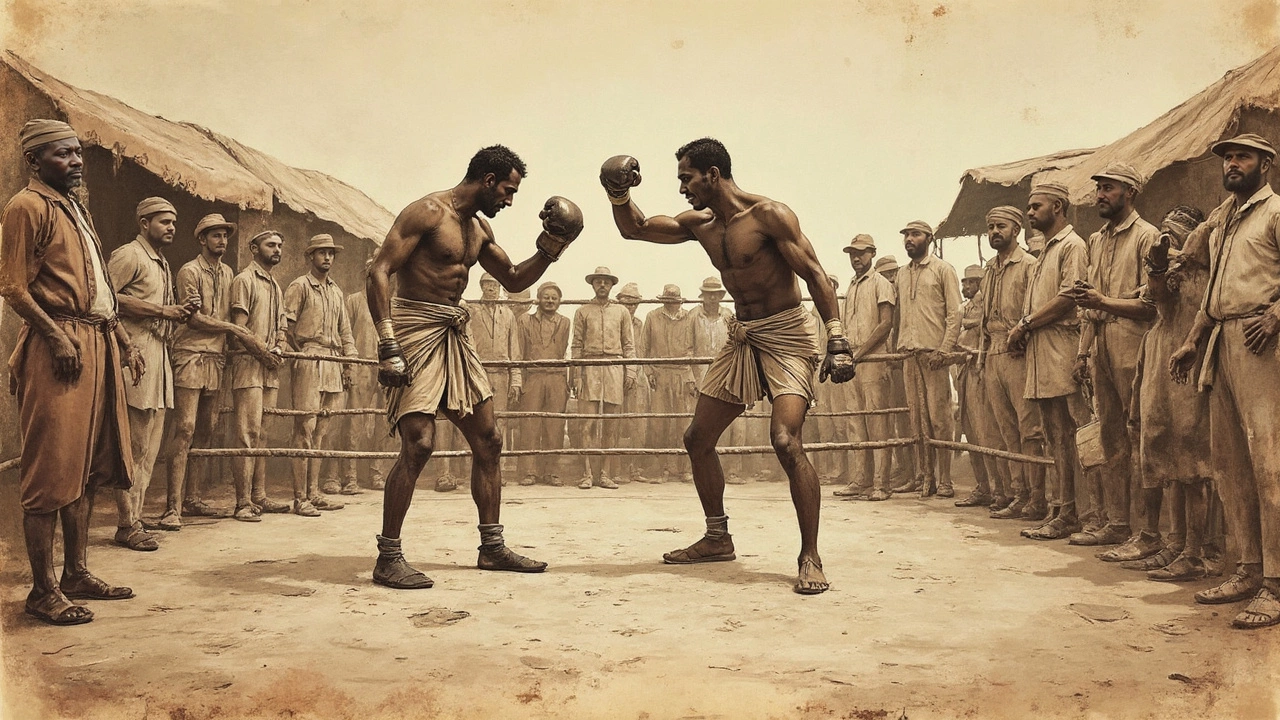If you've ever heard people talk about a "fighting match," especially for boxing, they're usually referring to a bout. That's the word used for an official contest between two boxers. You'll also hear terms like "fight," "matchup," and even "main event" when it's a big deal, but "bout" is the go-to in the ring.
Each boxing bout comes with pretty specific rules—number of rounds, time limits, and all sorts of checks set by the sanctioning body. This stuff isn't random. Promoters and officials spend days making sure everything is in order, from the boxer matchups to glove sizes and judge selections.
You'll notice boxing matches are usually held in a ring that's squarely marked out with ropes. Each bout has its own personality, but the basics stay the same: two fighters, a clear set of rules, and a referee right in the middle to keep things fair. If you want to sound like you know your stuff, calling it a "bout" gets you instant respect with real fans.
- What Do You Call a Boxing Match?
- How Boxers Are Matched Up
- Rounds, Rules, and Scoring Explained
- Different Types of Fights and Pro Tips
What Do You Call a Boxing Match?
If you’re wondering what the official name is for a boxing match, the word you want is "bout". This is the term used by athletic commissions, trainers, boxers, and fans. Whether it’s a local amateur clash or a world-title showcase in Vegas, every fight in the ring is called a bout.
The word "fight" is super common in conversations, but when things get formal—like in paperwork, rules, and official scorecards—it’s almost always “bout.” Announcers love to say, “Tonight’s bout is scheduled for 12 rounds,” and every ticket stub or program sticks to that word too.
You’ll also hear some other terms used for boxing matches:
- Match: The general term. It’s used in a bunch of other sports too, but in boxing, it might sound a bit informal to purists.
- Main event: This is what they call the headline fight of the night, usually last on the card.
- Undercard: These are the earlier bouts before the stars hit the ring. Sometimes, undercard fights are more exciting, to be honest.
If you’re ever at a boxing event and want to look like you know your stuff, saying “That was a great bout!” instead of “That was a cool fight!” makes you sound like a seasoned fan. Even broadcasters on sports networks say "bout" in score updates and post-match analysis segments.
Here’s a quick breakdown for reference:
| Term | When It's Used |
|---|---|
| Bout | Official documents, formal talk, announcer intros |
| Fight | Casual talk, fan chats, headlines |
| Main Event | Headlining match of the night |
| Undercard | Bouts before the main event |
So, next time someone asks what you call a boxing match, you can break it down for them—and maybe help them get comfortable with all the lingo too.
How Boxers Are Matched Up
You can't just throw two random people into a boxing match and call it fair. There’s a whole process for figuring out who fights whom, and it actually makes the sport way more interesting and safe.
First off, boxers are put into different weight classes. Lightweight, welterweight, heavyweight—these aren’t just cool names; they keep things level. Nobody wants to see a lightweight get flattened by a heavyweight giant.
After weight, there’s the whole thing about records. Promoters check each boxer’s record—how many wins, KOs, losses—to make sure the matchup is even. They want fights that’ll be competitive and exciting, not a boring mismatch. Rankings matter too. Fighters who are ranked closer together by big organizations (like the WBC or IBF) often wind up fighting each other because that’s how you move up the ladder.
- Boxing match promoters work with managers and trainers to find good matchups.
- Big matches get extra input: TV networks and sponsors, for example, can push for fights that grab viewers.
- Sometimes fighters call each other out—it’s not always about rankings, but also hype and demand.
If a match is for a title, the rules get stricter. Both fighters usually have to be ranked contenders. For world boxing matches, you need to be picked as a mandatory challenger or win an eliminator fight—a kind of playoff for a shot at the belt.
| Weight Class | Weight Limit (lb) |
|---|---|
| Lightweight | 135 |
| Welterweight | 147 |
| Middleweight | 160 |
| Heavyweight | 200+ |
The match-up process is about keeping things fair, exciting, and sometimes, a bit dramatic. That's how you get bouts that people talk about for years, not just another forgettable fight night.

Rounds, Rules, and Scoring Explained
Alright, when people talk about a boxing match or fighting match, rounds are a huge part of it. A standard professional bout has 12 rounds, with each round lasting three minutes and a one-minute break between them. Not every fight goes 12 rounds, though—some are set at 4, 6, 8, or 10, especially when it's early in a boxer's career or for local matches.
The main rule in a boxing match is simple: Hit with your gloves above the belt, and no kicking, headbutting, or wrestling moves. Fighters have to wear gloves—usually 8 to 10 ounces, depending on the weight class. Both boxers are weighed before the bout to make sure they're matched up fairly. If someone breaks the rules, the ref can take away points or even disqualify them. If you bite someone's ear (yeah, this happened), you're definitely getting thrown out.
Scoring uses the 10-point must system. In each round, the winner gets 10 points and the loser gets 9 or less. If there's a knockdown, the round might be scored 10-8 for the boxer who scored it. Three judges sit ringside tallying up the scorecards. Points can get confusing, so here's how a judge usually sees it:
- Clean punches landed (the more obvious, the better)
- Defensive moves (avoiding hits scores style points)
- Ring generalship (that's just a fancy way to say 'who controls the pace')
- Effective aggression (coming forward and making something happen)
You might wonder how draws or split decisions happen. If the judges don't agree, it can end in a split decision, majority decision, or even a draw. Here’s a quick table with some actual pro bout numbers to show how judges can see things differently:
| Judge | Boxer A | Boxer B |
|---|---|---|
| Judge 1 | 115 | 113 |
| Judge 2 | 113 | 115 |
| Judge 3 | 114 | 114 |
That’s how you sometimes get a split decision win or a draw, depending on what each judge saw in the bout. Odd, but it’s part of the drama that keeps fans on their toes.
Different Types of Fights and Pro Tips
If you think every boxing match is the same, there’s a lot you’re missing. Bouts come in all flavors, each with its own rules and reasons. Pro, amateur, title fights, eliminators — it can get a little confusing, so let’s clear things up.
Most people hear about pro fights, which are the big money events on TV. These fights usually run 10 to 12 rounds, each three minutes long. Only men’s world title matches go the full 12. On the amateur side, fights are shorter—usually three three-minute rounds for men and four two-minute rounds for women. Amateur bouts focus less on knockouts and more on points scored for clean hits.
Ever heard of an "exhibition" fight? These don’t count for a professional record. Think of them like sparring matches with the cameras rolling—celebrities and retired champions sometimes do these for fun or charity. There are also "eliminators," which are like playoffs: the winner gets a shot at a world title later.
- Bout: The official term for any boxing contest, pro or amateur.
- Main event: The headline fight of a card, usually with the biggest names or stakes.
- Undercard: Fights that happen before the main event. These introduce new talent or feature up-and-coming fighters.
- Title fight: A bout with a championship belt on the line.
- Rematch: When two fighters meet for the second (or third, or fourth) time after a tight or controversial first match.
To put some numbers in your corner, check out this simple breakdown:
| Type | Rounds | Purpose |
|---|---|---|
| Pro Fight | 10-12 (most) | Professional ranking or title |
| Amateur Fight | 3-4 | Development, Olympics, national tournaments |
| Exhibition | Variable | Entertainment, charity |
| Eliminator | 10-12 | Title shot qualifier |
Want a pro tip? If you're watching a boxing match for the first time, look for the way fighters pace themselves. Top professionals don't put everything out in round one. They play the long game, picking shots and adapting as the rounds tick by. And here's another tip: Judge who’s winning by who controls the center of the ring and lands clean punches—not just who punches more.
Also, don’t overlook the undercard. That’s where you spot the next big names, before everyone else is talking about them. If you remember one thing, it’s this: Every bout has its own story, but the basics—two fighters, clear rules, a win or loss—never change.





